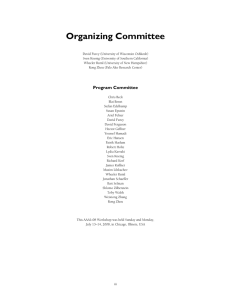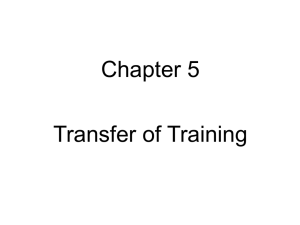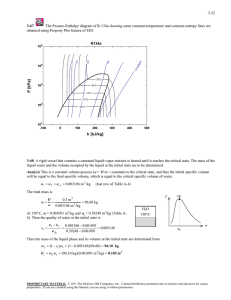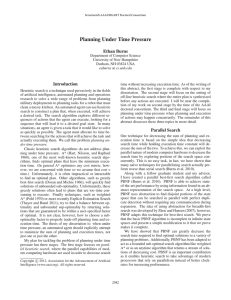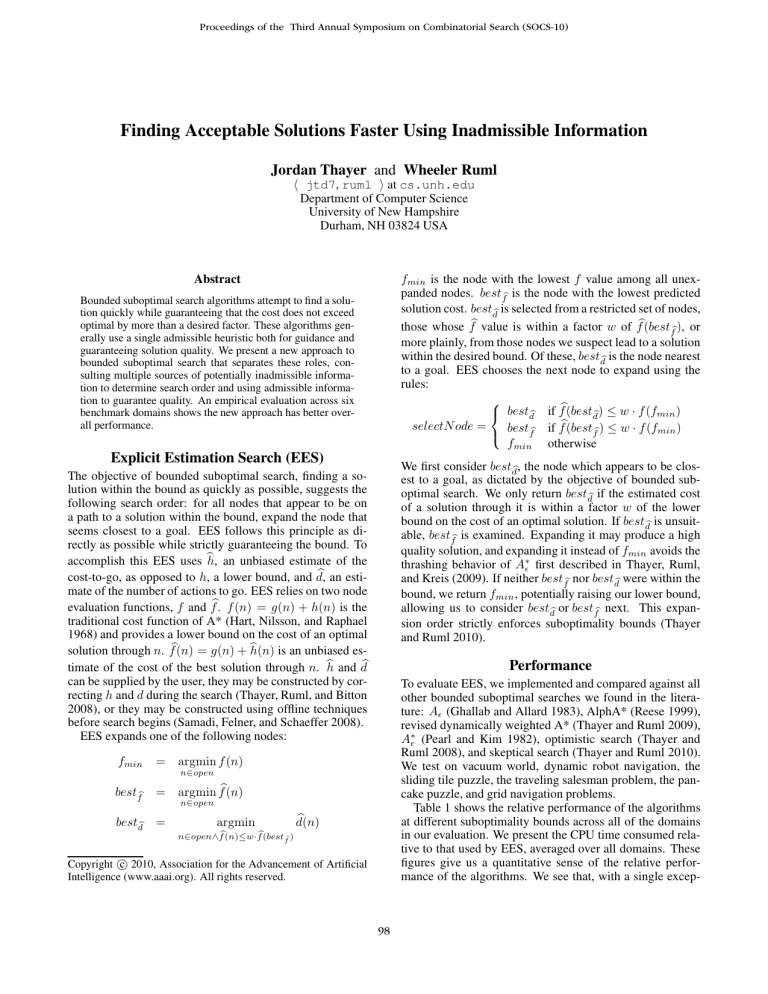
Proceedings of the Third Annual Symposium on Combinatorial Search (SOCS-10)
Finding Acceptable Solutions Faster Using Inadmissible Information
Jordan Thayer and Wheeler Ruml
h jtd7, ruml i at cs.unh.edu
Department of Computer Science
University of New Hampshire
Durham, NH 03824 USA
fmin is the node with the lowest f value among all unexpanded nodes. bestfb is the node with the lowest predicted
solution cost. bestdb is selected from a restricted set of nodes,
those whose fb value is within a factor w of fb(bestfb), or
more plainly, from those nodes we suspect lead to a solution
within the desired bound. Of these, bestdb is the node nearest
to a goal. EES chooses the next node to expand using the
rules:
bestdb if fb(bestdb) ≤ w · f (fmin )
selectN ode =
bestfb if fb(bestfb) ≤ w · f (fmin )
fmin otherwise
Abstract
Bounded suboptimal search algorithms attempt to find a solution quickly while guaranteeing that the cost does not exceed
optimal by more than a desired factor. These algorithms generally use a single admissible heuristic both for guidance and
guaranteeing solution quality. We present a new approach to
bounded suboptimal search that separates these roles, consulting multiple sources of potentially inadmissible information to determine search order and using admissible information to guarantee quality. An empirical evaluation across six
benchmark domains shows the new approach has better overall performance.
Explicit Estimation Search (EES)
We first consider bestdb, the node which appears to be closest to a goal, as dictated by the objective of bounded suboptimal search. We only return bestdb if the estimated cost
of a solution through it is within a factor w of the lower
bound on the cost of an optimal solution. If bestdb is unsuitable, bestfb is examined. Expanding it may produce a high
quality solution, and expanding it instead of fmin avoids the
thrashing behavior of A∗ǫ first described in Thayer, Ruml,
and Kreis (2009). If neither bestfb nor bestdb were within the
bound, we return fmin , potentially raising our lower bound,
allowing us to consider bestdb or bestfb next. This expansion order strictly enforces suboptimality bounds (Thayer
and Ruml 2010).
The objective of bounded suboptimal search, finding a solution within the bound as quickly as possible, suggests the
following search order: for all nodes that appear to be on
a path to a solution within the bound, expand the node that
seems closest to a goal. EES follows this principle as directly as possible while strictly guaranteeing the bound. To
accomplish this EES uses b
h, an unbiased estimate of the
b an esticost-to-go, as opposed to h, a lower bound, and d,
mate of the number of actions to go. EES relies on two node
evaluation functions, f and fb. f (n) = g(n) + h(n) is the
traditional cost function of A* (Hart, Nilsson, and Raphael
1968) and provides a lower bound on the cost of an optimal
solution through n. fb(n) = g(n) + b
h(n) is an unbiased estimate of the cost of the best solution through n. b
h and db
can be supplied by the user, they may be constructed by correcting h and d during the search (Thayer, Ruml, and Bitton
2008), or they may be constructed using offline techniques
before search begins (Samadi, Felner, and Schaeffer 2008).
EES expands one of the following nodes:
fmin
Performance
To evaluate EES, we implemented and compared against all
other bounded suboptimal searches we found in the literature: Aǫ (Ghallab and Allard 1983), AlphA* (Reese 1999),
revised dynamically weighted A* (Thayer and Ruml 2009),
A∗ǫ (Pearl and Kim 1982), optimistic search (Thayer and
Ruml 2008), and skeptical search (Thayer and Ruml 2010).
We test on vacuum world, dynamic robot navigation, the
sliding tile puzzle, the traveling salesman problem, the pancake puzzle, and grid navigation problems.
Table 1 shows the relative performance of the algorithms
at different suboptimality bounds across all of the domains
in our evaluation. We present the CPU time consumed relative to that used by EES, averaged over all domains. These
figures give us a quantitative sense of the relative performance of the algorithms. We see that, with a single excep-
= argmin f (n)
n∈open
bestfb = argmin fb(n)
n∈open
bestdb =
argmin
b
n∈open∧fb(n)≤w·f(best
)
fb
b
d(n)
Copyright c 2010, Association for the Advancement of Artificial
Intelligence (www.aaai.org). All rights reserved.
98
Cost Bound
optimistic
skeptical
A∗ǫ
wA*
Aǫ
AlphA*
Clamped
rdwA*
1.5
1.6
2.6
50.4
4.1
911.4
126.6
8.3
374.1
1.75
1.5
4.7
44.8
3.4
857.7
140.1
10.1
316.9
2.
1.6
4.9
28.5
2.8
683.2
181.6
11.6
245.1
3.
2.1
5.1
1.8
3.7
624.9
282.2
67.0
101.0
5.
2.1
13.9
0.6
2.4
614.3
315.0
85.8
128.1
employed, but has not yet seen wide use in bounded suboptimal search, largely because until now there were no techniques designed to make use of these inadmissible estimates.
Some techniques, such as optimistic search, decouple finding solutions and proving bounds, but they were designed to
use lower bounds for guidance and bounding, and generally
they fail to take advantage of distance to go information.
EES does both, and outperforms previous techniques as a
direct result.
Table 1: CPU time relative to EES
CPU
EES
Optimistic
Skeptical
A∗ǫ
wA*
Aǫ
AlphA*
Clamped
rdwA*
Generated
EES
Optimistic
Skeptical
A∗ǫ
wA*
Aǫ
AlphA*
Clamped
rdwA*
1st
0
0
3
2
1
0
0
0
0
1st
2
0
3
1
1
0
0
0
0
2nd
3
2
0
1
0
0
0
0
0
2nd
3
1
0
1
0
0
0
0
0
3rd
3
1
0
1
0
0
0
1
0
3rd
1
2
0
1
0
0
0
1
0
4th
0
3
1
0
2
0
0
0
0
4th
0
3
1
0
2
0
0
0
0
Conclusions
EES exploits additional information in bounded suboptimal
search, resulting in better search orders and shorter solving
times across a wide variety of benchmark domains. Unlike
previous approaches, explicit estimation search (EES) converts the stated goal of bounded subpotimal search rather
directly into an expansion order by taking advantage of inadmissible cost to go and search distance estimators that attempt to be unbiased rather than lower bounds. It is exactly
this decoupling of guidance and bounding that allows for the
improved performance of EES.
> 4th
0
0
2
3
3
6
6
5
6
> 4th
0
0
2
3
3
6
6
5
6
Acknowledgments
We gratefully acknowledge support from NSF (grant IIS0812141) and the DARPA CSSG program (grant HR001109-1-0021).
References
Ghallab, M., and Allard, D. 1983. Aǫ : An efficient near admissible
heuristic search algorithm. In Proceedings 8th IJCAI.
Hart, P. E.; Nilsson, N. J.; and Raphael, B. 1968. A formal basis for
the heuristic determination of minimum cost paths. IEEE Transactions of Systems Science and Cybernetics SSC-4(2):100–107.
Pearl, J., and Kim, J. H. 1982. Studies in semi-admissible heuristics. IEEE Transactions on Pattern Analysis and Machine Intelligence PAMI-4(4):391–399.
Reese, B.
1999.
AlphA∗ : An ǫ-admissible heuristic search algorithm.
Unpublished, retrieved from
http://home1.stofanet.dk/breese/papers.html.
Samadi, M.; Felner, A.; and Schaeffer, J. 2008. Learning from
multiple heuristics. In Proceedings of AAAI-08.
Thayer, J. T., and Ruml, W. 2008. Faster than weighted A*: An
optimistic approach to bounded suboptimal search. In Proceedings
of the Eighteenth International Conference on Automated Planning
and Scheduling (ICAPS-08).
Thayer, J., and Ruml, W. 2009. Using distance estimates in heuristic search. In Proceedings of ICAPS-2009.
Thayer, J., and Ruml, W. 2010. Finding acceptable solutions faster
using inadmissible information. Technical Report 10-01, University of New Hampshire.
Thayer, J. T.; Ruml, W.; and Bitton, E. 2008. Fast and loose in
bounded suboptimal heuristic search. In Proceedings of the First
International Symposium on Search Techniques in Artificial Intelligence and Robotics (STAIR-08).
Thayer, J.; Ruml, W.; and Kreis, J. 2009. Using distance estimates
in heuristic search: A re-evaluation. In Symposium on Combinatorial Search.
Table 2: Rank across all benchmarks
tion of A∗ǫ run with a bound of 5, EES consumes less time
than any other approach, despite its considerable overhead.
Table 2 summarizes performance of the algorithms on a
per domain basis, showing the number of times each algorithm achieved each ranking across all benchmarks when
ranked by the number of nodes generated and the amount
of CPU time consumed. When evaluating the relative performance of algorithms on a single domain, EES frequently
comes in second place; however, the difference in performance between it and the best algorithm for a domain is
typically very small. In contrast, the other algorithms fail
spectacularly in some domains, having performance many
times worse than the best algorithm. This makes their aggregate performance poor, as seen in Table 1. While EES
is rarely the best algorithm on a single domain, it is the superior algorithm when running on a set of problems with
diverse properties or when running on a novel domain.
Discussion
There are two important ideas that lead to the creation of
EES. The first is that a lower bound is inappropriate for
search guidance except when optimal solutions are absolutely required. This is well recognized for greedy search,
where more informed inadmissible heuristics are commonly
99


